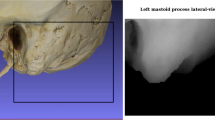Abstract
Since Broca noted a “sharpness” of the supraorbital margin of the female skull, this has been included among the features used for identification of sex, although there is no consistently applied, precise definition. We have investigated skulls from an anthropological collection and confirmed that part of this structure in the male is evenly rounded and trough-shaped in cross-section, whereas in the female the inner surface was found to be angular along the whole of its length. The reliability of this feature in the identification of sex from the skull was evaluated using impressions taken from 50 modern human skulls for which the age and sex were known (19 females and 31 males). The two different forms proved to be reliably identifiable, strongly related to sex, and the same on both left and right. The accuracy of identification of sex with this method was 75%.
Zusammenfassung
Seit Broca wird bei den geschlechts-differenten Merkmalen am Schädel eine „Schärfe” des weiblichen Orbitaorberrandes beschrieben, jedoch uneinheitlich und ungenau definiert. Aufgrund von Untersuchungen an Schädeln einer anthropologischen Sammlung konnte nachvollzogen werden, daß bei den männlichen Schädeln ein Teil des Oberrandes im Querschnitt einen gleichmäßig runden, trogförmigen Verlauf aufweist, während bei den weiblichen am Oberrand im gesamten Verlauf eine durchlaufende Knickbildung an der Innenseite ausgebildet ist. Mithilfe der vorgestellten Abdruck-methode wurde das Merkmal an 50 geschlechts- und altersbekannten rezenten Schädeln (19 ♀ ♀, 31 ♂ ♂) hinsichtlich seiner Wertigkeit bei Identifizierungsarbeiten am Schädel überprüft. Der Geschlechtsdimorphismus zeigte sich reliabel beurteilbar, streng geschlechtsbezogen und seitenunabhängig. Die Wahrscheinlichkeit einer richtigen Diagnose liegt bei ca. 75%.
Similar content being viewed by others
Literatur
Acsădi G, Nemeskéri J (1970) History of human lifespan and mortality. Akademiai Kiado, Budapest
Bass WM (1987) Human osteology — A laboratory and field manual. Missouri Archaeological Society
Broca P (1875) Instructions craniologiques et craniométriques. Mém Soc Anthropol Paris. T. II. 2. Serie
Ferembach D, Schwidetzky I, Stloukal M (1979) Empfehlungen für die Alters- und Geschlechtsdiagnose am Skelett. Homo 30: 1–31
Herrmann B, Grupe G, Hummel S, Piepenbrink H, Schutkowski H (1989) Prähistorische Anthropologie — Leitfaden der Feld- und Labormethoden. Springer, Berlin Heidelberg New York
Hunger H, Leopold D (1978) Identifikation. Springer, Berlin Heidelberg New York
Krogmann WM (1962) The human skeleton in forensich medicine. Charles C. Thomas, Springfield, Illinois
Rebentisch E (1893) Der Weiberschädel. Morphol Arbeiten II, 207–274
Sjøvold T (1988) Geschlechtsdiagnose am Skelett. In: Knußmann R (Hrsg) Wesen und Methoden der Anthropologie, Bd. II. Gustav Fischer, Stuttgart Jena New York, pp 444–496
Stewart TD (1948) Medico-legal aspects of the skeleton. I. Age, sex, race and stature. Am J Phys Anthropol 6: 315–321
Voigt K (1941) Geschlechtsunterschiede am menschlichen Schädel. Inaugural-Diss., Kiel
Author information
Authors and Affiliations
Rights and permissions
About this article
Cite this article
Graw, M., Haffner, H.T. & Czarnetzki, A. Methode zur Untersuchung des Margo supraorbitalis als Kriterium zur Geschlechtsdiagnose — Reliabilität und Validität. Rechtsmedizin 7, 121–126 (1997). https://doi.org/10.1007/BF03042388
Received:
Accepted:
Issue Date:
DOI: https://doi.org/10.1007/BF03042388




